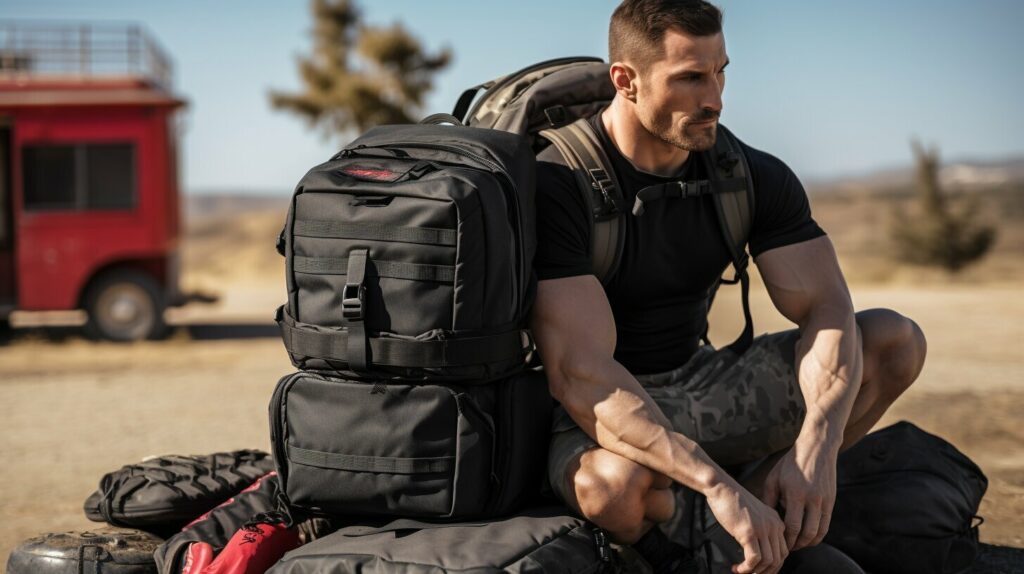“Rucking 101: A Beginner’s Guide to Getting Started”

Welcome to our comprehensive beginner’s guide to rucking, the effective fitness regime that involves walking with a weighted backpack. Rucking is a form of exercise that offers numerous physical and mental health benefits for both women and men. It can help build strength, endurance, and muscle, making it a great workout option for individuals looking to improve their fitness levels. In addition, rucking is a lower impact alternative to running, making it suitable for those seeking a more joint-friendly exercise. Parents of young children and individuals with busy schedules, including those who work from home, can also benefit from the convenience and flexibility of rucking.
To get started with rucking, it is essential to set parameters for your workouts and ensure you have the proper equipment. Using a backpack specifically designed for rucking is important to ensure comfort and functionality. You can add weight to your backpack using weight plates or dumbbells, gradually increasing the weight and distance over time as you become more accustomed to the exercise. Wearing appropriate footwear is crucial to prevent discomfort or injuries during your rucking sessions.
Incorporating strength training exercises into your rucking routine can further enhance your performance and prevent muscle imbalances. By targeting the specific muscles used during rucking, such as the legs, core, and upper body, you can optimize your overall strength and stability.
Key Takeaways:
- Rucking is a form of exercise that involves walking with a weighted backpack.
- It offers numerous physical and mental health benefits.
- Rucking can help build strength, endurance, and muscle.
- It is a lower impact alternative to running.
- Rucking can be a convenient and flexible workout option for parents and busy individuals.
What is Rucking?
Rucking, also known as weighted walking, is a form of exercise that involves walking with a backpack filled with weight. This weight can come from various sources such as weight plates or dumbbells, and it adds an extra challenge to the activity. Rucking is not just about walking with a heavy load; it is a deliberate and focused workout that offers numerous physical and mental health benefits for both women and men.
Rucking may seem simple, but it engages multiple muscle groups and provides an excellent full-body workout. It helps build strength, endurance, and muscle, making it an effective way to improve overall fitness. Additionally, rucking is a lower impact alternative to running, reducing strain on the joints while still providing a challenging cardiovascular workout.
Rucking is also a great fitness option for parents of young children. It can be easily incorporated into your daily routine, allowing you to spend quality time with your kids while getting in a workout. Whether you’re walking to school or exploring a local park, rucking is a convenient exercise that can be done almost anywhere.

“Rucking is more than just a workout; it’s a way to push yourself, both physically and mentally.”
To get started with rucking, it is crucial to set parameters for your workouts. Determine how much weight you can comfortably carry and choose a distance that suits your fitness level. Investing in a backpack specifically designed for rucking is essential for proper weight distribution and comfort.
Gradually increase the weight and distance over time, allowing your body to adapt and avoid overexertion or injury. It is also important to wear proper footwear that provides adequate support and cushioning for your feet and ankles.
Conclusion
Rucking is a challenging and rewarding exercise that offers a range of physical and mental health benefits. By incorporating rucking into your fitness routine, you can push your limits, improve your strength and endurance, and enjoy the convenience and flexibility it offers. So pack your backpack, put on your walking shoes, and start rucking for a fitter, stronger you!
The Basics of Rucking
To engage in rucking effectively, it is essential to understand and practice the basics of this exercise regime. Rucking is a fantastic way to build strength, endurance, and muscle while offering a lower impact alternative to running. Here are the key elements to keep in mind when starting your rucking journey:
- Proper Form: Maintain good posture throughout your rucking workouts. Keep your back straight, shoulders relaxed, and eyes forward. Engage your core muscles and take natural strides.
- The Right Backpack: Invest in a backpack specifically designed for rucking. It should be sturdy, comfortable, and have compartments to secure your belongings. Don’t forget to adjust the straps for a snug fit.
- Weight Selection: Begin with a manageable weight that challenges you but doesn’t strain your body. As you progress, gradually increase the weight of your backpack to keep pushing your limits. Some Rucking back packs do offer some customised weight options; you can view them here.
- Footwear: Wear proper footwear with good arch support and cushioning to protect your feet and ankles during your rucking workouts. It’s crucial to choose shoes that fit well and provide stability.
Rucking is not just about walking with a weighted backpack; it’s about doing it right. Remember to start slow and gradually build up your distance and intensity over time. By following these basics, you’ll be well on your way to enjoying the benefits of rucking.

Equipment Needed for Rucking
Choosing the right equipment is key to ensuring a successful rucking experience. The most important piece of equipment you will need is a sturdy and durable backpack specifically designed for rucking. Look for a backpack that has comfortable shoulder straps and a supportive back panel to distribute the weight evenly across your body. Additionally, consider a backpack with multiple compartments to help organize your gear.
To add weight to your backpack, you can use weight plates or dumbbells. Weight plates are a popular choice as they are designed to fit securely in the backpack’s dedicated weight compartment. Dumbbells, on the other hand, can be wrapped securely in a towel or placed in a padded sleeve to prevent shifting while rucking.
When it comes to footwear, opt for supportive and sturdy shoes or boots with good traction. Your footwear should provide ankle support and cushioning to protect your feet from impact. It’s also important to choose moisture-wicking socks to keep your feet dry and minimize the risk of blisters.
To help you visualize the necessary equipment, take a look at the image below:

Rucking offers a multitude of physical and mental health benefits for individuals of all fitness levels. This low-impact exercise involves walking with a weighted backpack, providing a unique and challenging workout experience. Here are some of the key health benefits of incorporating rucking into your fitness routine:
- Strength and Endurance: Rucking helps build strength and endurance by engaging multiple muscle groups throughout the body. The added weight of the backpack increases resistance, making your muscles work harder and leading to improved overall strength.
- Muscle Development: Rucking targets various muscle groups, including the legs, core, and back. Walking with the weighted backpack not only strengthens these muscles but also helps tone and define them over time.
- Low-Impact Alternative: For individuals looking for a low-impact alternative to running or other high-impact exercises, rucking is an excellent option. The backpack provides additional support and cushioning, reducing stress on the joints while still providing an effective cardiovascular workout.
“Rucking is a great way to challenge yourself physically and mentally. It’s a full-body workout that can be adapted to any fitness level, helping you reach your goals while minimizing the risk of injury.”
Furthermore, rucking can be particularly beneficial for parents of young children and individuals with busy schedules, including those who work from home. It offers the flexibility to fit workouts into tight schedules while still reaping the benefits of a challenging exercise routine. Whether you’re juggling parenting duties or balancing work and personal commitments, rucking can be a convenient and effective way to stay fit and healthy.
To get started with rucking, it’s important to set parameters for your workouts, choose the right equipment, and gradually increase the intensity over time. Consider investing in a backpack specifically designed for rucking, and add weight plates or dumbbells to adjust the resistance. Additionally, proper footwear is crucial to ensure comfort and reduce the risk of injury. Don’t forget to incorporate strength training exercises into your routine to target the specific muscles used during rucking and further enhance your performance.
Overall, rucking provides a fun and challenging workout experience that can help individuals push their limits and improve their overall fitness levels. With its numerous health benefits and flexibility, rucking is a fantastic addition to any fitness routine.

Rucking Workouts and Progression
Creating a structured rucking workout routine is crucial for making progress and achieving your fitness goals. Whether you are a beginner or experienced rucker, having a plan in place will help you stay motivated and track your progress. Here are some tips to help you create an effective rucking routine:
- Set specific goals: Determine what you want to achieve through rucking, whether it’s increasing endurance, building strength, or improving overall fitness.
- Start with a comfortable weight: Begin with a weight that challenges you but doesn’t strain your back or joints. It’s better to start lighter and gradually increase the weight as you get stronger.
- Gradually increase distance and weight: As your body adapts to rucking, gradually increase the distance and weight you carry. This progressive overload will help you continue making gains without overexerting yourself.
- Incorporate interval training: To add variety to your workouts and improve cardiovascular fitness, incorporate interval training into your rucking routine. Alternate between periods of brisk walking and slower recovery walks.
Remember to listen to your body and take rest days when needed. Rucking can be physically demanding, so it’s important to give your muscles and joints time to recover. And don’t forget to wear proper footwear to provide adequate support and prevent injuries.
The Importance of Strength Training
In addition to rucking, incorporating strength training exercises into your routine can further enhance your performance and prevent injuries. Focus on targeting the muscles used during rucking, such as your legs, core, and upper back. Here are some exercises to consider:
- Squats: Strengthen your lower body by performing bodyweight squats or adding weights to challenge yourself.
- Lunges: Work on your balance and leg strength with forward lunges, reverse lunges, or walking lunges.
- Planks: Build core stability and strength with planks, side planks, and other core exercises.
- Rows: Strengthen your upper back and shoulders with exercises like bent-over rows or seated rows.
By incorporating these exercises into your routine, you’ll improve your overall strength and stability, making your rucking workouts more effective.

Rucking for Parents and Busy Individuals
Rucking can be an ideal workout for parents and busy individuals looking to incorporate exercise into their daily routine. It offers a convenient and flexible fitness option that can be done at any time, anywhere. Whether you’re a stay-at-home parent or someone with a demanding work-from-home schedule, rucking allows you to stay active without the need for a gym or extensive equipment.
With a weighted backpack on your back, you can turn your daily walks into effective workouts. You can easily fit rucking into your schedule by simply grabbing your backpack and heading out for a walk around the neighborhood or during your lunch break. It’s a great way to make the most of your time while still getting a full-body workout.
“Rucking gives me a chance to exercise while spending time with my kids. I can take them for a walk in the park, and they can join in with their own mini backpacks. It’s a win-win for both of us!” – Busy Parent
One of the advantages of rucking is its adaptability. You can adjust the weight of your backpack based on your current fitness level or preference. As a beginner, you may start with a lighter load and gradually increase the weight as you build strength and endurance. Additionally, rucking can be a low-impact alternative to running, reducing the risk of joint injuries while still providing a challenging cardiovascular workout.
So, if you’re a parent looking for a way to stay active while spending time with your kids, or a busy individual searching for a convenient exercise option, give rucking a try. It’s a versatile and effective workout that can help you reach your fitness goals while fitting seamlessly into your daily routine.

In addition to rucking, incorporating strength training exercises into your routine can greatly enhance your overall fitness and rucking capabilities. By targeting the specific muscles used during rucking, you can improve your performance and reduce the risk of injuries. Here are some key strength training exercises to consider:
- Squats: This compound exercise engages multiple muscles, including the quadriceps, hamstrings, and glutes. Performing squats with proper form can help strengthen your lower body, which is essential for maintaining stability and power during rucking.
- Deadlifts: Deadlifts primarily target the posterior chain, including the glutes, hamstrings, and lower back. This exercise helps develop overall strength and stability, allowing you to maintain proper posture and carry the weighted backpack with ease.
- Shoulder Press: Strong shoulders are important for carrying the weight of the rucking backpack. Incorporate exercises like shoulder presses to build strength and stability in your deltoids, ensuring you can handle the load comfortably.
Additionally, exercises like lunges, step-ups, and farmer’s carries can further enhance your lower body strength and endurance, improving your ability to tackle longer and more challenging rucking workouts. Remember to start with lighter weights and focus on proper form before gradually increasing the intensity.
Proper Form and Safety
When performing strength training exercises, always prioritize proper form to prevent injuries and maximize results. It’s also crucial to listen to your body and give yourself adequate rest and recovery time between workouts. If you’re new to strength training, consider working with a qualified fitness professional to ensure you’re performing the exercises correctly and safely.
By incorporating strength training exercises into your rucking routine, you can take your fitness to new heights. Not only will you build the strength and endurance necessary for rucking, but you’ll also develop a well-rounded fitness foundation that can benefit you in various other physical activities. Remember to consult with a healthcare professional before starting any new exercise program, especially if you have pre-existing medical conditions.

Rucking is a challenging and rewarding fitness regime that can help individuals of all fitness levels improve their strength, endurance, and overall well-being. By walking with a weighted backpack, rucking provides a full-body workout that engages the muscles of the arms, back, core, and legs. Whether you’re a beginner or an experienced fitness enthusiast, rucking offers numerous physical and mental health benefits.
One of the key advantages of rucking is its versatility. It can be customized to suit your fitness goals and preferences. You have the freedom to set parameters for your workouts, such as the weight of your backpack and the distance you cover. This flexibility allows you to gradually increase the intensity of your rucking sessions over time, ensuring a safe and effective progression.
Proper equipment is essential for a successful rucking experience. Investing in a backpack specifically designed for rucking is crucial, as it provides comfort, durability, and appropriate weight distribution. You can enhance the challenge by adding weight plates or dumbbells to your backpack, allowing you to progressively increase the load as your strength improves.
Incorporating strength training exercises into your rucking routine can further enhance your performance. By targeting the specific muscles used during rucking, such as the shoulders, back, and legs, you can build strength and prevent injuries. Additionally, wearing proper footwear with adequate support and cushioning is important to protect your feet and joints during rucking.
Whether you’re a parent juggling childcare responsibilities, a busy individual with a hectic schedule, or simply looking for a new workout option, rucking is a convenient and effective choice. It offers a low-impact alternative to running, making it suitable for individuals of all ages and fitness levels. With its ability to improve strength, endurance, and mental well-being, rucking can help you achieve your fitness goals while enjoying the great outdoors.
In conclusion, rucking is a fun and challenging workout that can push your limits and improve your fitness levels. By setting parameters, using proper equipment, gradually increasing weight and distance, and incorporating strength training exercises, you can make the most out of your rucking experience. So grab your backpack, put on your walking shoes, and embark on a rucking adventure to boost your physical and mental well-being.
FAQ
Q: What is rucking?
A: Rucking is a form of exercise that involves walking with a weighted backpack.
Q: What are the health benefits of rucking?
A: Rucking offers numerous physical and mental health benefits, including building strength, endurance, and muscle. It is also a lower impact alternative to running.
Q: How do I get started with rucking?
A: To get started with rucking, it is important to set parameters for your workouts, use proper equipment such as a backpack with weight plates or dumbbells, and gradually increase the weight and distance over time.
Q: Are there any specific strength training exercises for rucking?
A: Yes, it is important to incorporate strength training exercises into your rucking routine to target the muscles used during rucking and improve performance.
Q: Can rucking be a good workout for parents?
A: Yes, rucking can be a great workout for parents of young kids due to its convenience and flexibility. It allows you to exercise while spending time with your children.
